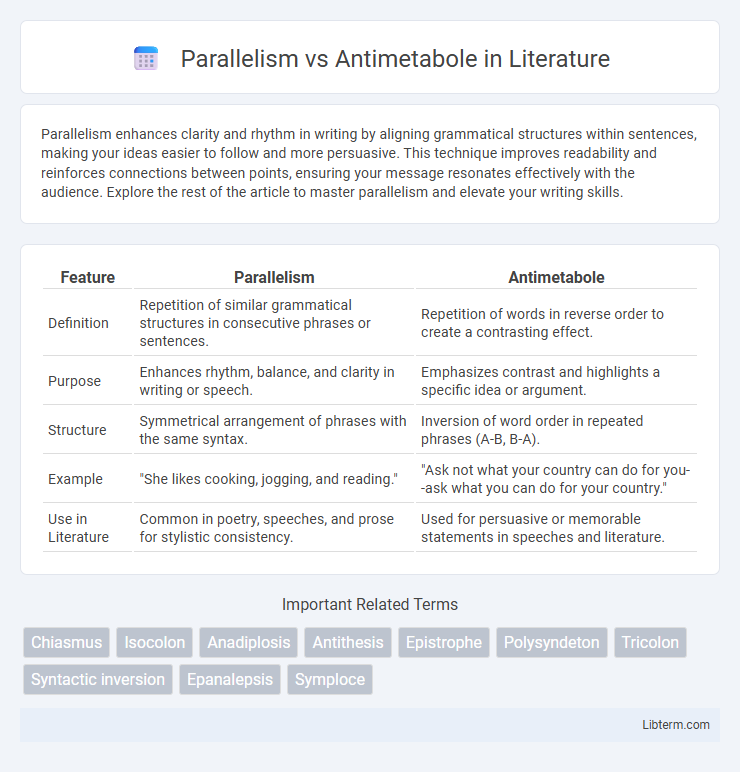Parallelism enhances clarity and rhythm in writing by aligning grammatical structures within sentences, making your ideas easier to follow and more persuasive. This technique improves readability and reinforces connections between points, ensuring your message resonates effectively with the audience. Explore the rest of the article to master parallelism and elevate your writing skills.
Table of Comparison
| Feature | Parallelism | Antimetabole |
|---|---|---|
| Definition | Repetition of similar grammatical structures in consecutive phrases or sentences. | Repetition of words in reverse order to create a contrasting effect. |
| Purpose | Enhances rhythm, balance, and clarity in writing or speech. | Emphasizes contrast and highlights a specific idea or argument. |
| Structure | Symmetrical arrangement of phrases with the same syntax. | Inversion of word order in repeated phrases (A-B, B-A). |
| Example | "She likes cooking, jogging, and reading." | "Ask not what your country can do for you--ask what you can do for your country." |
| Use in Literature | Common in poetry, speeches, and prose for stylistic consistency. | Used for persuasive or memorable statements in speeches and literature. |
Understanding Parallelism: Definition and Features
Parallelism is a rhetorical device that involves using similar grammatical structures or patterns in phrases or sentences to create balance and rhythm. Its key features include repetition of words, phrases, or sentence structures to emphasize ideas and enhance readability, making the text more persuasive and memorable. Parallelism often appears in lists, comparisons, and contrasts, highlighting the relationship between ideas through structural symmetry.
Exploring Antimetabole: Meaning and Characteristics
Antimetabole is a rhetorical device involving the repetition of words in reverse order to create a striking contrast or emphasis, exemplified by the phrase "Ask not what your country can do for you; ask what you can do for your country." This technique enhances memorability and impact by mirroring syntax while altering meaning, distinguishing it from parallelism, which simply involves the repetition of similar grammatical structures without reversal. Key characteristics of antimetabole include symmetry, word reversal, and the ability to convey profound insights or highlight contradictions through balanced phrasing.
Parallelism vs Antimetabole: Key Differences
Parallelism involves the repetition of similar grammatical structures in successive phrases or sentences to create rhythm and balance, enhancing clarity and emphasis. Antimetabole is a specific form of parallelism where the exact words are repeated in reverse order, often to highlight contrast or irony. The key difference lies in parallelism focusing on structural similarity, while antimetabole emphasizes word order reversal for rhetorical effect.
Historical Origins of Parallelism and Antimetabole
Parallelism dates back to ancient rhetorical traditions in Greek and Latin literature, where it was employed by orators like Cicero to create balanced and harmonious sentences enhancing persuasion. Antimetabole, a specific form of chiasmus, has its roots in classical rhetoric as well, with Plato and Aristotle using this technique to emphasize contrasting ideas through inverted word order. Both devices evolved from early rhetorical practices aimed at reinforcing memorability and impact in speech and writing.
Structural Patterns: How Each Device is Formed
Parallelism involves the repetition of similar grammatical structures within a sentence or series of sentences, creating rhythm and balance by aligning words, phrases, or clauses. Antimetabole is a specific type of parallelism that reverses the order of repeated words or phrases in successive clauses, forming a crisscross pattern such as "Ask not what your country can do for you; ask what you can do for your country." Both devices rely on carefully arranged syntactic patterns to enhance emphasis and memorability.
Rhetorical Effects and Purposes in Writing
Parallelism creates rhythm and balance by repeating grammatical structures, enhancing clarity and emphasizing key ideas to make writing more persuasive and memorable. Antimetabole, a specific form of parallelism that reverses word order in successive clauses, intensifies contrast and highlights paradoxes or contradictions, provoking thought and reinforcing arguments. Both devices engage readers emotionally and cognitively, with parallelism promoting harmony and flow, while antimetabole sharpens impact through striking reversal.
Famous Examples in Literature and Speeches
Parallelism and antimetabole are prominent rhetorical devices frequently seen in literature and iconic speeches. Parallelism involves the repetition of similar grammatical structures, as demonstrated in Martin Luther King Jr.'s "I Have a Dream" speech, where the repetitive structure amplifies the message's rhythm and impact. Antimetabole, exemplified by John F. Kennedy's phrase "Ask not what your country can do for you--ask what you can do for your country," reverses the order of words for emphasis, creating a memorable and thought-provoking statement.
Common Misconceptions and Overlaps
Parallelism and antimetabole are often confused due to their similar structural repetition, but parallelism involves repeating grammatical patterns while antimetabole specifically reverses the order of words in successive clauses. A common misconception is that all forms of word reversal qualify as antimetabole, whereas true antimetabole requires exact lexical repetition in inverted order. Both devices enhance rhetorical impact by emphasizing key ideas, yet their functional overlap can blur distinctions in stylistic analysis.
Practical Tips for Using Parallelism and Antimetabole
Parallelism enhances clarity and rhythm by repeating grammatical structures, making arguments more persuasive and easier to follow. Antimetabole, which reverses word order in parallel phrases, creates memorable, impactful statements ideal for emphasizing contrasts or reinforcing key points. To use these effectively, apply parallelism for balanced ideas and flow, and employ antimetabole selectively to highlight contradictions or craft catchy slogans.
Choosing the Right Device: Context and Impact
Parallelism emphasizes structural similarity across phrases to create rhythm and clarity, making it ideal for emphasizing balanced ideas. Antimetabole involves repeating words in reverse order, generating a striking contrast that highlights paradox or irony effectively. Selecting between the two depends on the desired impact: use parallelism for harmonious reinforcement and antimetabole for memorable, thought-provoking statements.
Parallelism Infographic

 libterm.com
libterm.com